An action plan makes easier to achieve your goal using a planned approach. It does not matter whether you manage a project or a department; an action plan will provide you with a path that you can follow to success.
Action plans also help you achieve goals in your personal life. It helps you or your team member keep motivated until the goal or objective is achieved.
In today’s post, we will discuss the action plan, its template, and an example.
What is an Action Plan?
An action plan is a detailed plan explaining the steps you should take to achieve your objective. It breaks the end goal into actionable steps to measure, follow, and track. It breaks the entire process into actionable assignments based on a timeline.
The action plan helps the project manager estimate the resources, effort, and budget required to achieve the objectives.
In project management, an action plan is like an implementation plan and helps the project manager during the project planning and execution phases.
Broadly, you can categorize action plans into three groups:
- Business Action Plan: A business action plan helps managers develop plans to achieve their business objectives (e.g., increasing sales, improving efficiency, launching or updating products, etc.).
- Project Action Plan: A project action plan helps project managers achieve project objectives successfully.
- Personal Action Plan: A personal action plan helps you achieve your personal goals or objectives (e.g., losing weight).
Action plans are also used in strategic planning. After creating strategic plans, you can develop an action plan to outline how you will achieve your strategic goals.
Action Plan Components
The action plan is a part of the project-management plan, and the project manager develops it in consultation with team members, subject-matter experts, and other stakeholders. Stakeholder involvement is necessary for action plan development to ensure that it has their support and fulfills their needs and requirements.
Effective action plans include the list of tasks and the name of the team member completing the task. It also includes resources needed by the task, duration, and any other dependency it may require.
How to Use an Action Plan
After creating the action plan, ensure you and your team follow it as is.
Monitor the progress closely to check any deviation from the path and carry out regular reviews to find if the progress is on track. If the project requires any changes, you can tweak the action plan to meet the project objectives.
The action plan is a live document and can be updated whenever required to achieve the desired result.
How to Create an Action Plan
You can follow the following steps to build your action plan:
#1. Define Your Objectives
All projects have objectives, and you must define them clearly. Ensure that the objectives are SMART.
SMART stands for:
- Specific: The objective must be clear and concise.
- Measurable: The objective must be measurable (e.g., in increments or milestones).
- Achievable: The objective must be realistically achievable.
- Relevant: The objective must align with the organization’s values and strategic objectives.
- Time-Bound: The objective must have a deadline so that progress can be tracked.
#2. Estimate Resources
The next step in writing an action plan is determining the resources required to complete the project. The resources include human resources, consumables, and equipment. You can involve your team members and other experts to estimate the project resources.
#3. Break Up the Work
Break down the project work into management work packages. You can use a work breakdown structure for this purpose. Ensure the work packages are logically related and don’t exceed three or four levels.
#4. Determine Required Actions
Determine the actions, tasks, or activities required to complete the task. To do so, you must further break the work packages into activity levels. Then, you will estimate the duration of the activities using your expert judgment and other estimation techniques.
#5. Assign Actions to Team Members
Now, you will assign each action to your team members based on their skills and capabilities. After assigning the roles and responsibilities, you will provide your team members with the required tools and authority to carry out the assigned responsibilities.
#6. Continuously Monitor Progress
This is a vital part of the action plan. You must monitor the efficiency of your action plan throughout the project life cycle. No plan goes as planned, and there are always hiccups. So be ready to update the plan and do it as needed to ensure your action plan is current, updated, and robust and reflects the current situation.
Action Plan Template
Goal/Objective: State your goal or objective clearly.
1. Define the Objectives:
- Clearly define what you want to achieve.
- Ensure the objectives are specific, measurable, achievable, relevant, and time-bound (SMART).
2. Identify Key Stakeholders:
- List all individuals or groups involved in or affected by this goal.
3. Assess the Current Situation:
- Analyze the current state or baseline.
- Identify any obstacles or challenges.
4. Set a Deadline:
- Determine the date by which you intend to achieve the goal.
5. Break Down the Goal:
- Divide the objectives into smaller, more manageable steps, tasks, or milestones.
- Assign responsibilities for each task.
6. Develop an Action Plan:
- Task 1, 2, 3, etc.:
- Description: Describe the task.
- Responsible Party: Specify who is responsible for this task.
- Start Date: Set a start date.
- End Date: Set a completion date.
- Resources Needed: List any resources required.
- Key Performance Indicators (KPIs): Define how you will measure success.
7. Allocate Resources:
- Identify and allocate resources (e.g., budget, personnel, and equipment) for each task.
8. Establish a Communication Plan:
- Establish a communication plan to keep stakeholders informed of progress and changes.
9. Monitor and Track Progress:
- Regularly review and update the action plan.
- Track the progress of each task and milestone.
10. Address Challenges:
- Identify potential obstacles and develop strategies to overcome them.
11. Celebrate Milestones:
- Recognize and celebrate achievements as milestones are reached.
12. Final Evaluation:
- Assess whether the objectives were achieved.
- Analyze what worked and what didn’t.
- Identify lessons learned.
13. Adjust and Improve:
- Use the insights from the evaluation to make improvements for future goals.
14. Reporting:
- Provide regular reports to stakeholders and relevant parties.
15. Documentation:
- Maintain records of the action plan, progress, and outcomes.
16. Review and Renew:
- If the goal is ongoing, establish a schedule for regular reviews and updates.
Remember that an action plan should be tailored to the specific objectives or project you are working on. Be as detailed as necessary to ensure clarity and effectiveness in achieving your objective.
Action Plan Example
Action Plan: Improving Employee Engagement
Goal/Objective: Increase employee engagement by 15% within 12 months.
1. Define the Objectives:
- Our objective is to improve employee engagement by 15% through initiatives and activities that enhance employee satisfaction, motivation, and overall job satisfaction.
2. Identify Key Stakeholders:
- HR Department
- Department Managers
- All Employees
- Employee Engagement Committee
3. Assess the Current Situation:
- Reviewing employee engagement survey results (i.e., baseline)
- Getting feedback from employees in recent meetings and interviews
- Identifying key pain points and challenges
4. Set a Deadline:
- 12 months from today
5. Break Down the Objectives:
- Conduct a monthly review-and-feedback session with employees.
- Implement monthly team-building activities.
- Provide professional development opportunities.
- Enhance communication channels and feedback mechanisms.
- Recognize and reward outstanding performance.
6. Develop an Action Plan:
- Task 1: Monthly Review and Feedback Sessions
- Description: Conduct monthly feedback sessions with employees to discuss concerns, suggestions, and improvements.
- Responsible Party: HR Department
- Start Date: Month 1
- End Date: Ongoing
- Resources Needed: Meeting space, survey tools
- KPIs: Participation rate, feedback implementation rate
- Task 2: Monthly Team-Building Activities
- Description: Organize monthly team-building activities to foster better working relationships and team cohesion.
- Responsible Party: Employee Engagement Committee
- Start Date: Month 2
- End Date: Ongoing
- Resources Needed: Budget, event-planning resources
- KPIs: Participation rate, post-activity surveys
- Task 3: Professional Development Opportunities
- Description: Identify and provide training and development opportunities for employees to enhance their skills.
- Responsible Party: Department Managers
- Start Date: Month 3
- End Date: Ongoing
- Resources Needed: Training budget, training materials
- KPIs: Participation rate, skill improvement
- Task 4: Enhance Communication Channels
- Description: Implement regular departmental meetings, open-door policies, and online suggestion boxes.
- Responsible Party: HR Department
- Start Date: Month 4
- End Date: Ongoing
- Resources Needed: Communication tools, training for managers
- KPIs: Participation rate, suggestions received
- Task 5: Recognition and Rewards Program
- Description: Develop and implement an employee recognition and rewards program.
- Responsible Party: HR Department
- Start Date: Month 5
- End Date: Ongoing
- Resources Needed: Budget for rewards, program design
- KPIs: Employee satisfaction, engagement survey results
7. Allocate Resources:
- Allocate budget for team building activities, professional development, and rewards program.
- Allocate time and personnel for feedback sessions and communication enhancements.
8. Establish a Communication Plan:
- Communicate the action plan to all employees through company-wide meetings and email updates.
9. Monitor and Track Progress:
- Conduct monthly progress reviews with department managers.
- Conduct quarterly engagement surveys.
10. Address Challenges:
- Develop strategies to address any challenges that arise during implementation.
11. Celebrate Milestones:
- Celebrate achievements at quarterly milestones.
12. Final Evaluation:
- After 12 months, assess whether a 15% improvement in employee engagement has been achieved.
13. Adjust and Improve:
- Use employee feedback and the final evaluation to make improvements for future engagement initiatives.
14. Reporting:
- Provide regular progress reports to the leadership team and all employees.
15. Documentation:
- Maintain records of survey results, meeting notes, and feedback received.
16. Review and Renew:
- If needed, create a plan to improve employee engagement continuously beyond the initial 12-month period.
This action plan provides a structured approach to improving employee engagement within a specific time frame. It outlines the tasks, responsible parties, resources, and key performance indicators to measure progress and success.
Project Action Vs Implementation Plan
A project action plan and an implementation plan are two distinct documents used in project management, each serving a specific purpose.
The purpose of the project action is to outline the high-level steps and activities required to achieve the project’s objectives. It is more of a strategic document. It includes project goals, key project milestones, responsible parties, timelines, and a list of major tasks or actions that must be taken.
The action plan focuses on what needs to be done, but it doesn’t give detailed instructions on how each task will be executed.
The purpose of the project implementation plan is to provide a detailed, tactical document that outlines how the project’s objectives will be achieved.
The project implementation plan provides a comprehensive guide for executing the project. It includes detailed task descriptions, resource allocation, budget details, dependencies, risk management, communication plans, and a timeline with precise deadlines.
The implementation plan delves into the specifics of who will do what, how it will be done, and when it will be completed, thus ensuring that everyone involved understands their roles and responsibilities.
The project action plan provides all the actions needed to achieve the project objectives, while the project implementation plan is a detailed blueprint that guides project execution. The action plan serves as the initial roadmap, and the implementation plan serves as the detailed navigation guide. Both documents are vital for the project’s success.
Summary
An action plan plays a key role in achieving project success by documenting the project management plan’s execution. Ensure that you have a realistic and robust action plan to lead your project towards success.

I am Mohammad Fahad Usmani, B.E. PMP, PMI-RMP. I have been blogging on project management topics since 2011. To date, thousands of professionals have passed the PMP exam using my resources.







